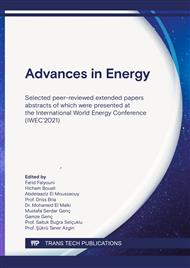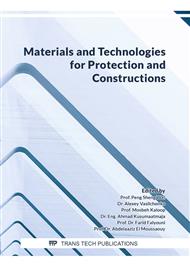[1]
J. Baron, J-P. Ollivier, La durabilité des bétons, Presse de l'École nationale des ponts et chaussées, (1992).
Google Scholar
[2]
Z. Zhang, X.D. Shao, and P. Zhu, Direct tensile behaviors of steel-bar reinforced ultra-high performance fiber reinforced concrete: Effects of steel fibers and steel rebars, Construction and Building Materials. 243 (2020): 118054.
DOI: 10.1016/j.conbuildmat.2020.118054
Google Scholar
[3]
Information on https://www.ginger-cebtp.com/laboratoire-dessais/etudes-et-essais-sur-les-betons.
Google Scholar
[4]
B. Redjel, M. Yahiaoui, La mesure de la résistance du béton à la traction, in: F. Mekideche-Chafan, et al., Algérie équipement, Ecole nationale supérieure des travaux publics, Alger, Algérie, 2020, pp.28-35.
DOI: 10.7451/cbe.2017.59.1.1
Google Scholar
[5]
D.L. Nguyen, M.N.T. Lam, D.J. Kim and J. Song, Direct tensile self-sensing and fracture energy of steel-fiber-reinforced concretes, Composites Part B: Engineering. 183 (2020): 107714.
DOI: 10.1016/j.compositesb.2019.107714
Google Scholar
[6]
C. Bian, J-Y. Wang, and J-Y. Guo, Damage mechanism of ultra-high performance fibre reinforced concrete at different stages of direct tensile test based on acoustic emission analysis, Construction and Building Materials. 267 (2021): 120927.
DOI: 10.1016/j.conbuildmat.2020.120927
Google Scholar
[7]
W. Shin and D-Y. Yoo, Influence of steel fibers corroded through multiple microcracks on the tensile behavior of ultra-high-performance concrete, Construction and Building Materials. 259 (2020): 120428.
DOI: 10.1016/j.conbuildmat.2020.120428
Google Scholar
[8]
Y. Yao, F.A. Silva, M. Butler, V. Mechtcherine and B. Mobasher, Tensile and Flexural Behavior of Ultra-High-Performance Concrete (UHPC) under Impact Loading, International Journal of Impact Engineering. 153 (2021): 103866.
DOI: 10.1016/j.ijimpeng.2021.103866
Google Scholar
[9]
D.Y. Yoo, H.K. Sohn, P.H. Borges, R. Fediuk and S. Kim, Enhancing the tensile performance of ultra-high-performance concrete through strategic use of novel half-hooked steel fibers, Journal of Materials Research and Technology. 9.3 (2020): 2914-2925.
DOI: 10.1016/j.jmrt.2020.01.042
Google Scholar
[10]
J.J. Kim, Y.S. Jang and D-Y. Yoo, Enhancing the tensile performance of ultra-high-performance concrete through novel curvilinear steel fibers, Journal of Materials Research and Technology. 9.4 (2020): 7570-7582.
DOI: 10.1016/j.jmrt.2020.05.072
Google Scholar
[11]
M.H. Naser, F.H. Naser and M.K. Dhahir, Tensile behavior of fiber reinforced cement mortar using wastes of electrical connections wires and galvanized binding wires, Construction and Building Materials. 264 (2020): 120244.
DOI: 10.1016/j.conbuildmat.2020.120244
Google Scholar
[12]
R. Guo, H. Ren, L. Zhang, Z. Long, X. Jiang, X. Wu and H. Wang, Direct dynamic tensile study of concrete materials based on mesoscale model, International Journal of Impact Engineering. 143 (2020): 103598.
DOI: 10.1016/j.ijimpeng.2020.103598
Google Scholar
[13]
L. Chen, C. Yue, Y. Zhou, J. Zhang, X. Jiang and Q. Fang, Experimental and mesoscopic study of dynamic tensile properties of concrete using direct-tension technique, International Journal of Impact Engineering. 155 (2021): 103895.
DOI: 10.1016/j.ijimpeng.2021.103895
Google Scholar
[14]
British Standard Institution, Testing hardened concrete-Part 5: Flexural strength of test specimens, BS EN (2009): 12390-5.
Google Scholar
[15]
British Standard Institution, Testing Hardened Concrete-Part 6: Tensile Splitting Strength Of Test Specimens, BS EN (2009): 12390-6.
DOI: 10.3403/30200045
Google Scholar
[16]
X. Régal, Caractérisation du comportement en traction du béton sous fortes sollicitations: essais de flexion trois points aux barres de Hopkinson, doctoral thesis, Université d'Orléans, (2016).
Google Scholar
[17]
S.F. Resan, S.M. Chassib, S.K. Zemam, and M.J. Madhi, New approach of concrete tensile strength test, Case Studies in Construction Materials. 12 (2020): e00347.
DOI: 10.1016/j.cscm.2020.e00347
Google Scholar
[18]
Norme homologuée française, Bétons - Essais d'étude, de convenance et de contrôle - Confection et conservation des éprouvettes NF P 18-404 (1981).
Google Scholar
[19]
X. Jourdain, H.H. Molinaro, Fabrication d'une poutre en béton armé (2018).
Google Scholar
[20]
P. Kumar Mehta, Paulo J. M. Monteiro, Concrete: Microstructure, Properties, and Materials. 4th ed. New York: McGraw-Hill Education, (2014).
Google Scholar
[21]
M.I. Khan, Direct tensile strength measurement of concrete, Applied mechanics and materials, Trans Tech Publications Ltd. 117-119 (2012): 9-14.
Google Scholar
[22]
J.J Kim, and M. Reda Taha, Experimental and numerical evaluation of direct tension test for cylindrical concrete specimens, Advances in Civil Engineering. 2014 (2014).
DOI: 10.1155/2014/156926
Google Scholar
[23]
S. Swaddiwudhipong, H. R. Lu, and T. H. Wee, Direct tension test and tensile strain capacity of concrete at early age, Cement and concrete research. 33.12 (2003): 2077-2084.
DOI: 10.1016/s0008-8846(03)00231-x
Google Scholar
[24]
J. Dashti and M. Nematzadeh, Compressive and direct tensile behavior of concrete containing Forta-Ferro fiber and calcium aluminate cement subjected to sulfuric acid attack with optimized design, Construction and Building Materials. 253 (2020): 118999.
DOI: 10.1016/j.conbuildmat.2020.118999
Google Scholar
[25]
J. Donnini, G. Lancioni, G. Chiappini and V. Corinaldesi, Uniaxial tensile behavior of ultra-high performance fiber-reinforced concrete (UHPFRC): experiments and modeling, Composite Structures. 258 (2021): 113433.
DOI: 10.1016/j.compstruct.2020.113433
Google Scholar
[26]
F. Liu, W. Ding and Y. Qiao, Experimental investigation on the tensile behavior of hybrid steel-PVA fiber reinforced concrete containing fly ash and slag powder, Construction and Building Materials. 241 (2020): 118000.
DOI: 10.1016/j.conbuildmat.2020.118000
Google Scholar



